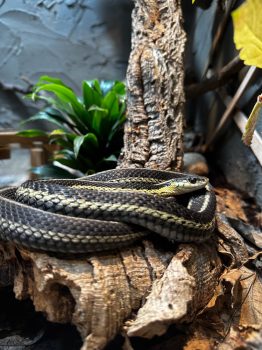Eastern Garter Snake
Common Name: Eastern Garter Snake
Scientific Name: Thamnophis sirtalis
Names: Fate
Locations: Whitby, Vaughan & London

Diet
Eastern Garter Snakes are carnivorous and opportunistic feeders. Their diet mainly consists of amphibians (such as frogs and toads), earthworms, small fish, and occasionally small rodents and invertebrates.
Average lifespan
In the wild, Eastern Garter Snakes typically live around 10 to 15 years, with some individuals reaching older ages under favorable conditions.
Size
These snakes are relatively small to medium in size, usually growing to lengths of about 60 to 90 centimeters (24 to 36 inches).
Weight
Adult Eastern Garter Snakes generally weigh between 100 to 200 grams, depending on their overall size and condition.
About
Eastern Garter Snakes are one of the most common snake species in North America. They are widely distributed across the eastern United States and parts of Canada, inhabiting a variety of environments including meadows, forests, wetlands, and even suburban areas. Known for their harmless nature to humans, these non-venomous snakes play a vital role in controlling populations of amphibians and small mammals.
Size and behavior
Eastern Garter Snakes have slender, agile bodies with distinctive longitudinal stripes that can range in color from yellow to green or blue. They are primarily diurnal and are frequently seen basking in the sun to regulate their body temperature. During cooler months, they often hibernate in large communal dens, a behavior that helps increase their chances of survival during winter.
Diet and nutrition
With their varied diet of amphibians, small fish, and invertebrates, Eastern Garter Snakes obtain a balanced mix of proteins and fats necessary for energy and growth. Their feeding behavior involves using their keen sense of smell and sensitivity to environmental cues to locate prey, which is essential for maintaining their active lifestyle.
Conservation status
The Eastern Garter Snake is classified as Least Concern by conservation authorities. Its widespread distribution and stable population numbers indicate that, despite localized threats from habitat alteration and environmental changes, the species as a whole remains relatively secure.
Fun fact
Eastern Garter Snakes are remarkable for their communal hibernation behavior; during winter, hundreds of individuals may gather together in a single hibernaculum (den) to overwinter. This social behavior not only conserves heat but also provides protection against predators and harsh weather conditions.
Call or visit your local Reptilia Facility to learn how you can adopt one of these amazing reptiles.










